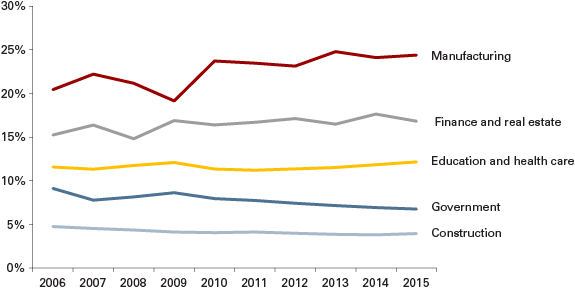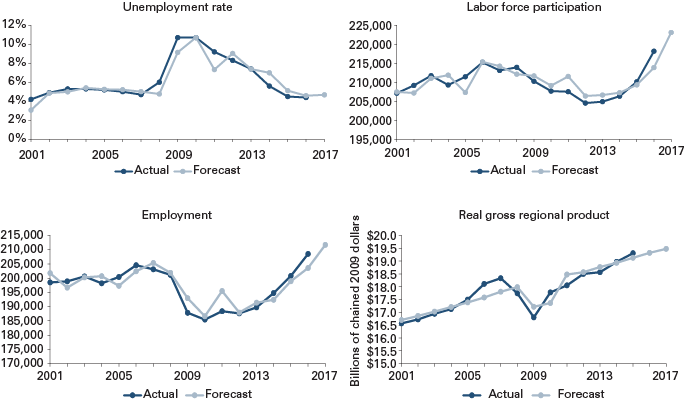Fort Wayne forecast 2017
Professor, Department of Economics, Indiana University–Purdue University Fort Wayne
Assistant Professor, Department of Economics, Indiana University–Purdue University Fort Wayne
Employment
Labor market conditions in the Fort Wayne Metropolitan Statistical Area (MSA)—which consists of Allen, Whitley and Wells counties—have continued steadily improving over the past six years. The number employed in the Fort Wayne MSA displays a clear upward trend from 2010 through September 2016. The latest data show that the number of employed in the Fort Wayne MSA in September 2016 stood at 210,437, compared to its pre-recession level of 204,866 in September 2006—the last “normal” year prior to the Great Recession (December 2007 to June 2009). Employment numbers clearly show a labor market that has recovered to its pre-recession levels (see Figure 1).
Figure 1: Fort Wayne MSA annual employment

Note: 2016 is the January-September average.
Source: U.S. Bureau of Labor Statistics
Table 1 shows the top five sectors that contributed to the surge in employment in the Fort Wayne MSA since 2010. Employment in the services sector increased by 19 percent, while leisure and hospitality grew by 13 percent. Education and health care, as well as manufacturing, have had employment growth of 11 percent. Meanwhile, construction experienced a 9 percent employment growth. The four largest sectors in employment all experienced double-digit employment growth.
Table 1: Top five contributing industries to employment in the Fort Wayne MSA: Index since 2010
| Year | Education and health care | Construction | Manufacturing | Services | Leisure and hospitality |
|---|---|---|---|---|---|
| 2010 | 1.00 | 1.00 | 1.00 | 1.00 | 1.00 |
| 2011 | 1.01 | 1.03 | 1.03 | 1.04 | 1.02 |
| 2012 | 1.05 | 1.00 | 1.05 | 1.05 | 1.04 |
| 2013 | 1.07 | 1.02 | 1.07 | 1.10 | 1.06 |
| 2014 | 1.08 | 1.04 | 1.09 | 1.14 | 1.09 |
| 2015 | 1.11 | 1.09 | 1.11 | 1.19 | 1.13 |
Note: Values in this table are indexed to 2010.
Source: U.S. Bureau of Labor Statistics
Comparing changes in employment in the Fort Wayne MSA relative to Indiana and the United States, we observe that the recession hit Indiana and the Fort Wayne MSA much harder than it did the nation as a whole. Post-recession, employment recovery in the Fort Wayne MSA proceeded in tandem with that of Indiana and the United States; however, the pace of recovery has been slower in the Fort Wayne MSA (see Figure 2).
Figure 2: Change in employment since 2006

Note: 2016 is the average of January-September data.
Source: U.S. Bureau of Labor Statistics
While employment was back to its pre-recession levels by 2013 for the U.S., it took an additional year for Indiana to bounce back and two more years after that for the Fort Wayne MSA to catch up to its pre-recession employment levels. The data, however, do contain good news for the Fort Wayne MSA because it shows a surge in employment since 2014 (as seen in Figure 2).
Unemployment
Unemployment in the Fort Wayne MSA climbed to 10.7 percent in 2009—a rate that was more than double its pre-recession level of 5 percent in 2006. Similarly, between 2006 and 2010, the number of unemployed more than doubled from 10,673 to 22,234. Since 2010, however, both the number of unemployed and the unemployment rate have declined systematically. The average unemployment rate for 2016 (using January through September monthly data) is 4.3 percent. This rate is 0.2 percent below the 4.5 percent for 2015, reinforcing an optimistic picture of labor market conditions in the Fort Wayne MSA. Furthermore, while local fluctuations in the unemployment rate have been closely related to those for the state and the nation, the Fort Wayne MSA has had a lower unemployment rate than Indiana and the U.S. since 2014 (see Figure 3).
Figure 3: Annual unemployment rates

Note: 2016 is the average of January-September data.
Source: U.S. Bureau of Labor Statistics
Labor force
Another bellwether indicator of labor market conditions is the labor force, which consists of those employed plus those unemployed and looking for work. It is important to track movements of the labor force because normally, for a growing population, we would expect the labor force to be increasing. However, during an economic downturn, where jobs are hard to come by and the duration of unemployment increases, the number of discouraged workers—those who are without a job, but stop looking for work—increases and, therefore, the labor force decreases. On the other hand, when labor market conditions are improving, with normal growth in the population, the labor force will increase. This will occur when the number of employed goes up more than the fall in the unemployed. The labor force can also increase when the numbers of both employed and unemployed increase as those who dropped out re-enter the labor market and start looking for jobs, thus joining the ranks of the unemployed. Either way, we would expect the labor force to rise during “good” times in the labor market.
In 2006, the Fort Wayne MSA’s labor force stood at 215,207. With the onset of recession in 2007, the labor force continued declining through 2012 (with the exception of 2008 when it staged a brief comeback). It took until 2016 for the metro’s labor force to return to pre-recession levels. The labor force is currently sitting at 218,794— mostly due to the acceleration in its growth since 2015, but especially in 2016 (see Figure 4). In addition, the right axis of Figure 4 shows the changes in labor force relative to its 2006 base level. In 2012, for example, the Fort Wayne MSA’s labor force was at 95 percent of its pre-recession level, while in 2016 it was about 2 percent above the 2006 level.
Figure 4: Fort Wayne labor force and change in labor force

Note: 2016 is the average of January-September data.
Source: U.S. Bureau of Labor Statistics
Taken together, movements of employment, unemployment and labor force suggest improving labor market conditions post-recession, with current conditions suggesting a labor market at or very near “full-employment” conditions.
Gross regional product
Inflation-adjusted gross regional product (GRP) for the Fort Wayne MSA recovered to its pre-recession levels of just over $18.1 billion by 2011. Since 2011, the region’s total output has grown at an average rate of 1.7 percent to about $19.3 billion in 2015. This trend bodes well for continued growth in the region in the coming year (see Figure 5).
Figure 5: Fort Wayne MSA real GRP

Source: U.S. Bureau of Economic Analysis
Examination of contribution to the regional GRP growth by sector shows that the largest value-generating sector in the Fort Wayne MSA continues to be manufacturing, at about 25 percent of GRP. The next largest sectors are finance and real estate at about 17 percent and then health care and education at about 12 percent of GRP. The government and construction sectors account for 7 percent and 4 percent, respectively (see Figure 6).
Figure 6: Fort Wayne MSA contribution to real GRP

Source: U.S. Bureau of Economic Analysis
Earnings and income
Income and earnings in Fort Wayne continue to be a challenge despite recent gains. Inflation-adjusted annual pay per worker started to increase since 2013, four years after the end of the recession and reached $42,000 in 2015, slightly above where it was in 2006. However, this level still lags the state and the nation. Indiana reached $44,000 and the nation was nearly $53,000 for comparison (see Figure 7).
Figure 7: Real annual pay per worker

Note: Data are in 2015 dollars.
Source: U.S. Bureau of Labor Statistics, Quarterly Census of Employment and Wages
Forecast
Forecasts for the main economic and labor market indicators for the Fort Wayne MSA in 2017 paint an encouraging picture. The most conservative estimates show that, in 2017, the Fort Wayne MSA’s economy may expand to $19.5 billion (in 2009 dollars), a 1 percent increase relative to the 2015 level. In 2017, the unemployment rate is predicted to be in the 4.5-4.7 percent range, which is slightly above the current rate. The number of individuals in the labor force is expected to increase to 223,085, which is 2 percent growth relative to the 2016 level. Finally, the number of employed workers will increase to 211,661, or a 1.5 percent increase relative to the current year (see Figure 8).
Figure 8: Fort Wayne MSA forecasts for key indicators

Note: Time-series statistical tools were utilized to estimate the numbers for 2017.
Source: U.S. Bureau of Labor Statistics and U.S. Bureau of Economic Analysis
Notes
- The authors wish to thank Dr. David A. Dilts for his helpful comments.



